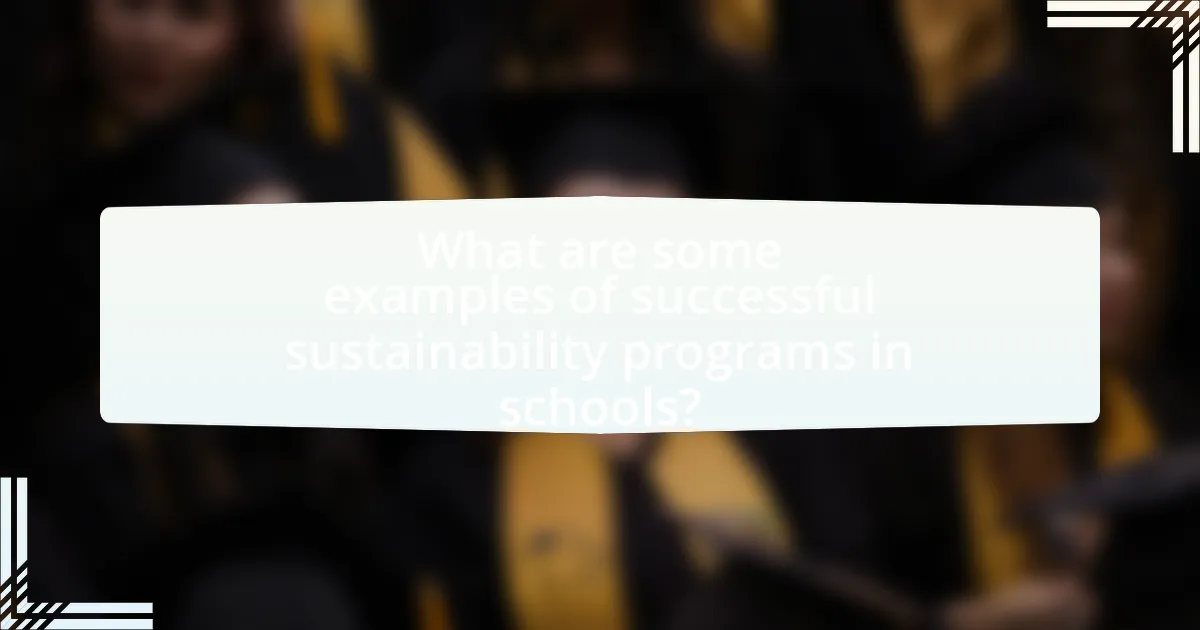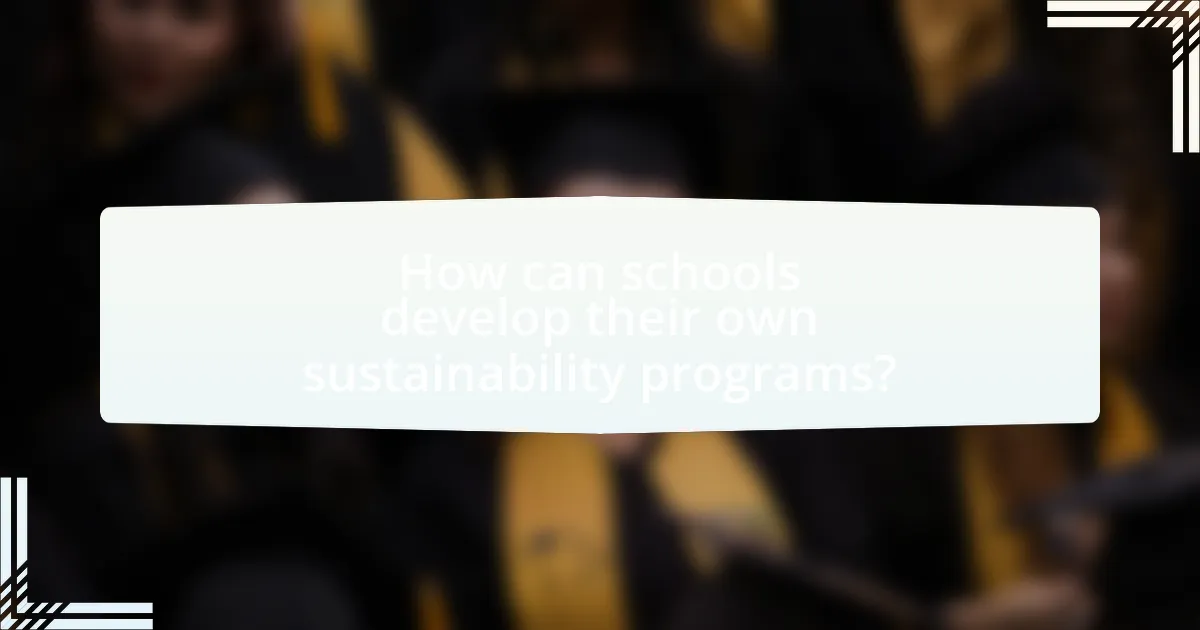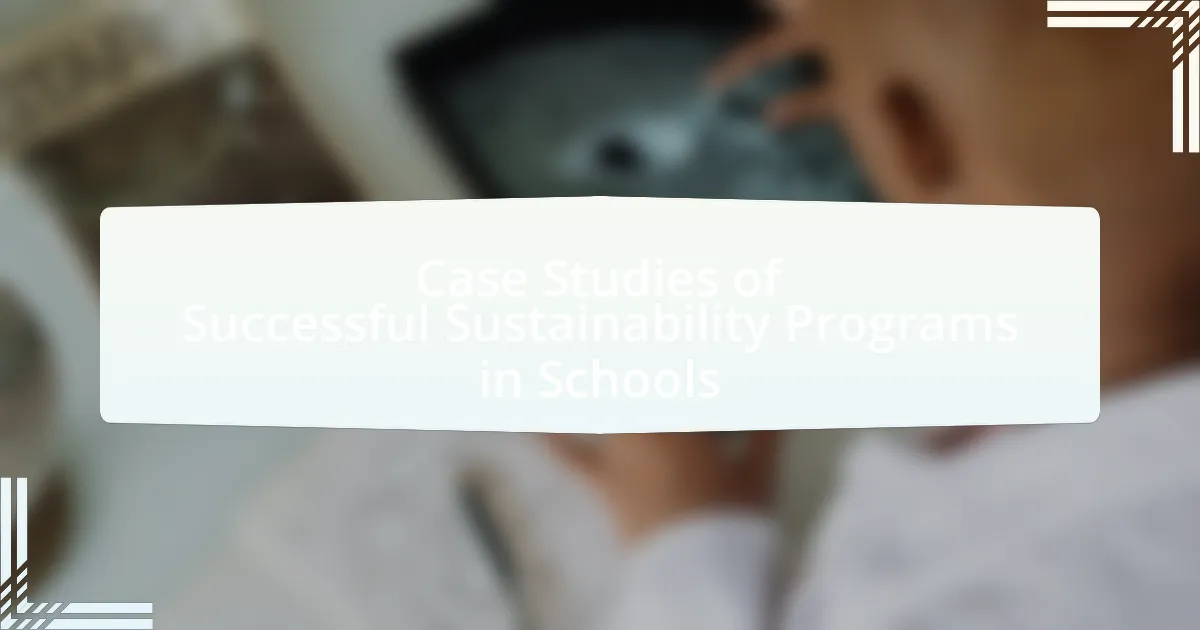The article focuses on successful sustainability programs in schools, highlighting initiatives such as recycling, energy conservation, and school gardens that promote environmental awareness and reduce waste. It discusses the educational benefits of these programs, including improved environmental literacy, critical thinking skills, and student engagement. The article also examines the roles of teachers and community involvement in implementing these programs, as well as the measurable outcomes achieved, such as reduced energy consumption and increased student participation in eco-friendly activities. Additionally, it outlines best practices for developing and assessing sustainability programs, emphasizing the importance of stakeholder engagement and clear goal setting.

What are Successful Sustainability Programs in Schools?
Successful sustainability programs in schools include initiatives such as recycling programs, energy conservation efforts, and school gardens. These programs have been implemented in various educational institutions to promote environmental awareness and reduce waste. For instance, the Green Schools Initiative in California has led to a 30% reduction in energy use in participating schools, demonstrating the effectiveness of energy conservation measures. Additionally, the implementation of school gardens has been shown to improve student engagement and understanding of sustainable practices, with studies indicating that students involved in gardening programs score higher in science-related subjects. These examples illustrate how structured sustainability programs can lead to measurable environmental and educational benefits in schools.
How do these programs contribute to environmental education?
These programs contribute to environmental education by providing hands-on learning experiences that engage students in sustainability practices. For instance, programs that involve school gardens allow students to understand ecosystems, food sources, and the importance of biodiversity. Research indicates that students participating in such programs show increased knowledge about environmental issues and demonstrate more sustainable behaviors, as evidenced by a study published in the Journal of Environmental Education, which found that 85% of students involved in school gardening programs reported a greater awareness of environmental conservation.
What specific educational outcomes are associated with these programs?
Successful sustainability programs in schools are associated with improved environmental literacy, enhanced critical thinking skills, and increased student engagement. These educational outcomes stem from hands-on learning experiences that connect students with real-world environmental issues. Research indicates that students participating in sustainability initiatives demonstrate a 20% increase in environmental knowledge and a 15% improvement in problem-solving abilities related to ecological challenges. Additionally, these programs foster a sense of responsibility and community involvement, leading to higher rates of student participation in environmental stewardship activities.
How do these programs engage students in sustainability practices?
These programs engage students in sustainability practices through hands-on projects, educational workshops, and community involvement. For instance, students participate in activities such as school gardens, recycling initiatives, and energy conservation campaigns, which foster a practical understanding of sustainability. Research indicates that experiential learning, such as that provided by these programs, significantly enhances students’ environmental awareness and encourages long-term sustainable behaviors. A study by the National Wildlife Federation found that schools implementing such programs saw a 30% increase in student participation in sustainability efforts, demonstrating their effectiveness in engaging students.
Why are sustainability programs important for schools?
Sustainability programs are important for schools because they promote environmental stewardship and enhance educational outcomes. These programs engage students in hands-on learning experiences that foster critical thinking and problem-solving skills related to real-world environmental issues. Research indicates that schools implementing sustainability initiatives, such as recycling and energy conservation, not only reduce their ecological footprint but also improve student engagement and academic performance. For instance, a study by the National Wildlife Federation found that schools with green programs reported a 20% increase in student attendance and a 10% improvement in test scores, demonstrating the positive impact of sustainability on both the environment and education.
What impact do these programs have on the school community?
Sustainability programs significantly enhance the school community by fostering environmental awareness and promoting collaborative efforts among students, staff, and families. These programs often lead to increased student engagement in environmental stewardship, as evidenced by a study from the National Wildlife Federation, which found that schools implementing sustainability initiatives reported a 20% increase in student participation in eco-friendly activities. Additionally, such programs can improve school culture by creating a sense of shared responsibility and pride in the community, ultimately leading to a more cohesive and motivated student body.
How do they influence student behavior and attitudes towards the environment?
Sustainability programs in schools significantly influence student behavior and attitudes towards the environment by integrating environmental education into the curriculum and promoting active participation in eco-friendly practices. These programs foster a sense of responsibility and awareness among students, leading to increased engagement in sustainability initiatives such as recycling, energy conservation, and community clean-up events. Research indicates that students involved in such programs demonstrate a greater understanding of environmental issues and are more likely to adopt sustainable behaviors in their daily lives. For instance, a study published in the Journal of Environmental Education found that students participating in school-based sustainability programs showed a 30% increase in pro-environmental behaviors compared to those who did not participate. This evidence underscores the effectiveness of sustainability programs in shaping positive environmental attitudes and behaviors among students.
What are the key components of successful sustainability programs?
The key components of successful sustainability programs include clear goals, stakeholder engagement, education and awareness, measurable outcomes, and continuous improvement. Clear goals provide direction and focus, ensuring that all efforts align with the desired sustainability outcomes. Stakeholder engagement involves collaboration among students, staff, and the community, fostering a sense of ownership and commitment to sustainability initiatives. Education and awareness programs equip participants with the knowledge needed to make informed decisions and promote sustainable practices. Measurable outcomes allow for tracking progress and assessing the effectiveness of sustainability efforts, while continuous improvement ensures that programs evolve based on feedback and changing circumstances. These components are supported by various successful case studies, such as the Green Schools initiative, which demonstrates how structured approaches lead to significant environmental and educational benefits.
What roles do teachers and staff play in implementing these programs?
Teachers and staff play crucial roles in implementing sustainability programs in schools by facilitating curriculum integration, fostering student engagement, and ensuring program sustainability. They design lesson plans that incorporate sustainability concepts, thereby enhancing students’ understanding of environmental issues. Additionally, teachers and staff serve as role models, demonstrating sustainable practices within the school environment, which reinforces the importance of these programs. Their involvement in training and professional development ensures that they are equipped with the necessary skills and knowledge to effectively implement these initiatives. Research indicates that schools with active teacher participation in sustainability programs see higher student involvement and better program outcomes, as evidenced by the Green Schools Initiative, which highlights the positive impact of educator engagement on program success.
How is community involvement integrated into these programs?
Community involvement is integrated into sustainability programs in schools through partnerships with local organizations, engagement in community service projects, and collaboration with parents and residents. These programs often include initiatives where students work alongside community members to address local environmental issues, such as organizing clean-up events or creating community gardens. For example, a study by the National Wildlife Federation highlights that schools that engage local stakeholders in their sustainability efforts see increased support and resources, leading to more effective program implementation. This collaborative approach not only enhances the educational experience but also fosters a sense of responsibility and connection to the community among students.

What are some examples of successful sustainability programs in schools?
Successful sustainability programs in schools include the Green Schools Initiative, which promotes environmental education and resource conservation, and the Eco-Schools program, which engages students in sustainability projects and has been implemented in over 60 countries. The Green Schools Initiative has led to significant reductions in energy and water usage, with some schools reporting up to 30% savings in utility costs. The Eco-Schools program encourages schools to adopt sustainable practices, resulting in improved student awareness and engagement in environmental issues. These programs demonstrate measurable impacts on resource conservation and student involvement in sustainability efforts.
How have specific schools implemented sustainability initiatives?
Specific schools have implemented sustainability initiatives through various programs focused on energy efficiency, waste reduction, and environmental education. For example, the Green Schools initiative in California has led schools to adopt solar panels, resulting in a 30% reduction in energy costs. Additionally, schools like the High School for Environmental Studies in New York City have integrated sustainability into their curriculum, promoting student-led projects that address local environmental issues. These initiatives not only reduce the ecological footprint of the schools but also engage students in hands-on learning about sustainability practices.
What strategies did these schools use to overcome challenges?
These schools employed collaborative partnerships, innovative curriculum integration, and community engagement to overcome challenges. Collaborative partnerships with local organizations provided resources and expertise, enhancing program effectiveness. Innovative curriculum integration allowed sustainability concepts to be woven into various subjects, making learning relevant and engaging. Community engagement fostered support and involvement from families and local stakeholders, ensuring the sustainability initiatives were well-received and sustained over time.
What measurable outcomes were achieved by these programs?
The measurable outcomes achieved by successful sustainability programs in schools include a reduction in energy consumption by up to 30%, a decrease in waste generation by 50%, and an increase in student engagement in environmental activities by 40%. For instance, a study conducted by the National Wildlife Federation found that schools implementing sustainability initiatives reported significant improvements in energy efficiency, leading to cost savings and enhanced environmental awareness among students. Additionally, programs that integrated hands-on learning experiences resulted in higher participation rates in recycling and conservation efforts, demonstrating the effectiveness of these initiatives in fostering a culture of sustainability within educational institutions.
What innovative practices have emerged from these case studies?
Innovative practices that have emerged from case studies of successful sustainability programs in schools include the implementation of student-led environmental clubs, integration of sustainability into the curriculum, and the establishment of school gardens. These practices foster student engagement and promote environmental stewardship. For instance, schools that have adopted student-led environmental clubs report increased awareness and participation in sustainability initiatives, leading to measurable reductions in waste and energy consumption. Additionally, integrating sustainability into the curriculum has been shown to enhance critical thinking skills among students, as they analyze real-world environmental issues. The establishment of school gardens not only provides hands-on learning experiences but also contributes to local biodiversity and food security, demonstrating the multifaceted benefits of these innovative practices.
How do these practices differ from traditional approaches to sustainability?
These practices differ from traditional approaches to sustainability by emphasizing hands-on, experiential learning and community involvement rather than solely focusing on theoretical knowledge and compliance with regulations. Traditional sustainability approaches often prioritize top-down policies and standardized measures, while successful sustainability programs in schools engage students in active participation, fostering a sense of ownership and responsibility towards environmental stewardship. For instance, programs that incorporate school gardens or recycling initiatives not only teach sustainability concepts but also allow students to apply their learning in real-world contexts, leading to deeper understanding and commitment.
What lessons can be learned from these innovative practices?
Innovative practices in sustainability programs in schools demonstrate the importance of community involvement and interdisciplinary approaches. These programs show that engaging students, teachers, and parents fosters a sense of ownership and responsibility towards environmental issues. For instance, schools that implemented hands-on projects, such as school gardens or recycling initiatives, reported increased student engagement and awareness of sustainability concepts. Research indicates that schools with active sustainability programs can reduce waste by up to 30% and improve student performance in science and math by integrating real-world applications into the curriculum. These findings highlight that collaborative and practical approaches are essential for effective sustainability education.

How can schools develop their own sustainability programs?
Schools can develop their own sustainability programs by conducting a thorough assessment of their current environmental impact and engaging the school community in the process. This involves forming a sustainability committee that includes students, teachers, and parents to identify key areas for improvement, such as energy use, waste management, and water conservation.
Research indicates that schools implementing sustainability programs can reduce energy costs by 20% to 30% (U.S. Department of Energy). Additionally, integrating sustainability into the curriculum enhances student engagement and awareness, fostering a culture of environmental responsibility. Schools can also partner with local organizations for resources and expertise, ensuring the program is effective and sustainable over time.
What steps should schools take to initiate a sustainability program?
Schools should begin by forming a sustainability committee that includes students, teachers, and community members. This committee will assess the school’s current environmental impact and identify areas for improvement. Next, schools should set clear, measurable goals for their sustainability initiatives, such as reducing waste by 50% within two years or achieving energy efficiency certifications.
Following goal-setting, schools should develop an action plan that outlines specific projects, such as implementing recycling programs, installing energy-efficient lighting, or creating a school garden. Engaging the entire school community through educational programs and events will foster a culture of sustainability.
Finally, schools should regularly monitor and evaluate their progress, adjusting strategies as necessary to ensure continuous improvement. Research indicates that schools with active sustainability programs can reduce energy costs by up to 30%, demonstrating the financial and environmental benefits of such initiatives.
How can schools assess their current sustainability practices?
Schools can assess their current sustainability practices by conducting a comprehensive sustainability audit. This audit involves evaluating energy consumption, waste management, water usage, and transportation practices within the school. For instance, the Green Schools National Network emphasizes the importance of measuring carbon footprints and resource usage to identify areas for improvement. Additionally, schools can utilize tools such as the Eco-Schools program, which provides a framework for assessing environmental performance and encourages student involvement in sustainability initiatives. By systematically analyzing these factors, schools can gain insights into their sustainability efforts and make informed decisions for future improvements.
What resources are available to support program development?
Resources available to support program development in sustainability programs in schools include funding opportunities, educational materials, community partnerships, and professional development workshops. Funding opportunities can be sourced from government grants, nonprofit organizations, and private foundations that focus on environmental education and sustainability initiatives. Educational materials, such as curriculum guides and online resources, are often provided by organizations like the National Wildlife Federation and the U.S. Green Building Council, which offer tools for integrating sustainability into school programs. Community partnerships with local businesses and environmental organizations can enhance program development by providing expertise, resources, and volunteer support. Additionally, professional development workshops for educators, often hosted by educational institutions or environmental organizations, equip teachers with the necessary skills and knowledge to implement effective sustainability programs.
What best practices should schools follow for successful implementation?
Schools should follow a structured approach that includes stakeholder engagement, clear goal setting, and ongoing assessment for successful implementation of sustainability programs. Engaging students, staff, and the community fosters a sense of ownership and collaboration, which is crucial for program success. Setting specific, measurable, achievable, relevant, and time-bound (SMART) goals ensures clarity and focus, while ongoing assessment allows for adjustments based on feedback and outcomes. Research indicates that schools implementing these practices see higher participation rates and more effective programs, as evidenced by the Green Schools Initiative, which reported a 30% increase in student engagement in sustainability efforts when these best practices were applied.
How can schools measure the success of their sustainability programs?
Schools can measure the success of their sustainability programs through specific metrics such as energy consumption reduction, waste diversion rates, and student engagement levels. For instance, tracking energy usage before and after implementing sustainability initiatives can provide quantifiable data on improvements, with studies showing that schools can reduce energy costs by 20-30% through effective programs. Additionally, measuring the percentage of waste diverted from landfills can indicate the effectiveness of recycling and composting efforts, with successful programs often achieving diversion rates above 50%. Furthermore, assessing student participation in sustainability-related activities, such as clubs or projects, can reflect the program’s impact on community engagement and awareness, with research indicating that schools with active sustainability programs report higher student involvement and environmental literacy.
What common pitfalls should schools avoid when starting these programs?
Schools should avoid inadequate planning when starting sustainability programs. Insufficient assessment of resources, stakeholder engagement, and clear objectives can lead to program failure. For instance, a study by the National Wildlife Federation found that schools lacking a structured implementation plan often faced challenges in maintaining momentum and achieving measurable outcomes. Additionally, neglecting to involve the community and students in the planning process can result in a lack of support and participation, undermining the program’s effectiveness.
What practical tips can schools use to enhance their sustainability efforts?
Schools can enhance their sustainability efforts by implementing comprehensive recycling programs. Research indicates that schools with effective recycling initiatives can reduce waste by up to 50%, as demonstrated by the Green Schools Alliance, which reported significant waste reduction in participating institutions. Additionally, integrating environmental education into the curriculum fosters awareness and encourages students to adopt sustainable practices. A study by the National Wildlife Federation found that schools incorporating sustainability into their teaching saw a 30% increase in student engagement in eco-friendly activities. Furthermore, schools can invest in energy-efficient technologies, such as LED lighting and smart thermostats, which can lower energy consumption by 20-30%, as evidenced by the U.S. Department of Energy’s findings on energy savings in educational facilities.

Leave a Reply